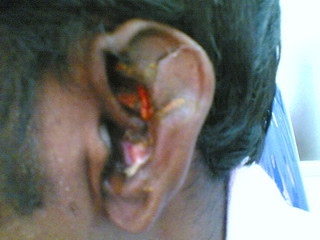Perichondritis Pinna
Contents
Definition:
This term refers to infection / inflammation involving the perichondrium of the external ear, which includes the auricle and external auditory canal. It is commonly used to describe a series of conditions of external ear ranging from erysipelas (infections of skin), cellulitis (infections of soft tissue), and true perichondritis to chondritis (infections involving the cartilage).
Classification:
Erysipelas of external ear
Cellulitis of external ear
Perichondritis
Chondritis
Etiology:
It commonly occurs due to trauma. Trauma includes laceration of auricle, surgery to external ear, frost bite, burns, chemical injury, high piercing of ear lobe to insert ear rings, infection of hematoma of pinna.
Superficial infections of skin lining (erysipelas) Infections involving subcutaneous tissue (cellulitis)
Infections involving the perichondrium (perichondritis)
Infections of cartilage (cartilage)
Microbiology:
Organisms commonly isolated include Pseudomonas aeruginosa and staphylococcus aureus.
Clinical features:
Dull aching pain involving the cartilagenous portion of pinna. The ear lobule which is devoid of cartilage is spared. Classic signs of inflammation are clearly demonstrable. The pain is more severe in perichondritis when compared to erysipelas or cellulitis.This condition should be differentiated from relapsing polychondritis. Relapsing polychondritis is associated with systemic effects like fever. Perichondritis when left untreated causes necrosis of the underlying cartilage causing deformities of pinna (cauliflower ear).
Management:
Prevention: Perichondritis can be prevented by placing the ear prick sites well away from the cartilage of the pinna (over the ear lobule).Hematomas of auricle should be drained immediately following aseptic precautions.Burn injuries of pinna should be carefully managed.Mild forms of perichondritis can be managed by a course of broad spectrum antibiotics, administered preferably in high doses. Subperichondial abscess should be drained immediately.In resistant and recurrent cases Button surgery can be performed. Continuous drainage of subperichondrial abscess can be resorted to in resistant cases by placing polythene tubes over the site of incision. Topical Antibiotics can also be administered through these tunes. Topical antibiotics can be of use because the cartilage is devoid of blood supply and systemic antibiotics may not reach the cartilage in adequate concentrations.Highly resistant cases may be managed by low dose radiation which could kill the micro organisms. Three or four sittings of 0.8 Gy radiation may be used over a period of two days.
